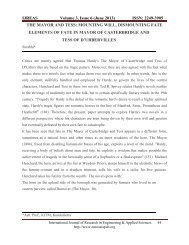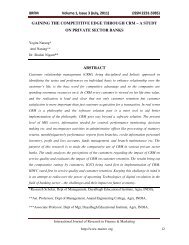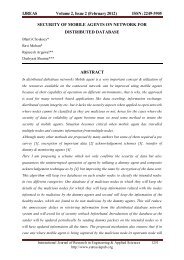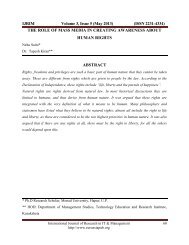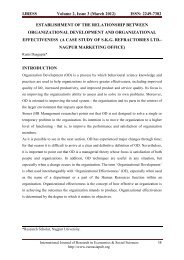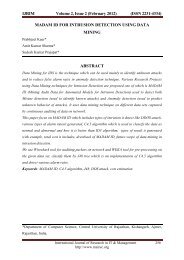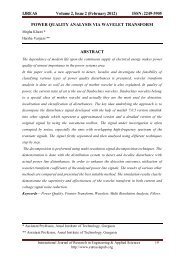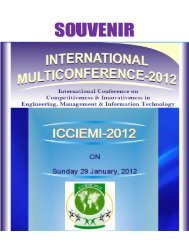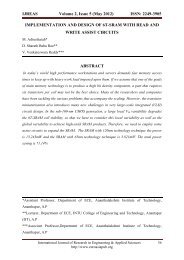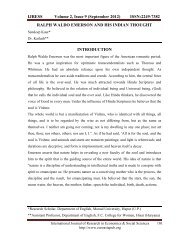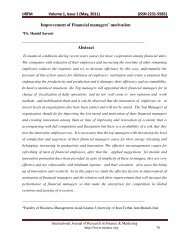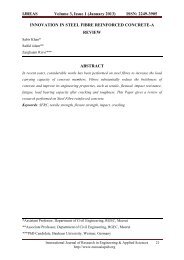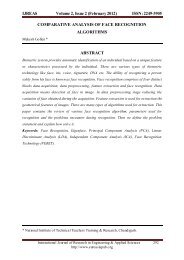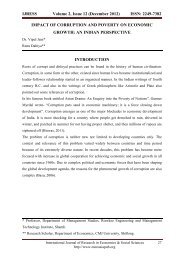study on the growth and yield of mushroom white ... - Euroasiapub.org
study on the growth and yield of mushroom white ... - Euroasiapub.org
study on the growth and yield of mushroom white ... - Euroasiapub.org
Create successful ePaper yourself
Turn your PDF publications into a flip-book with our unique Google optimized e-Paper software.
IJREAS Volume 2, Issue 4 (April 2012) ISSN: 2249-3905STUDY ON THE GROWTH AND YIELD OF MUSHROOM WHITEROT FUNGI – PLEUROTUS SPECIESAnju *INTRODUCTIONMushrooms, <strong>the</strong> biological potential <strong>of</strong> <strong>the</strong>se <strong>white</strong> rot fungi are far from exploited. Inadditi<strong>on</strong> to <strong>the</strong> traditi<strong>on</strong>al bioc<strong>on</strong>versi<strong>on</strong> <strong>of</strong> <strong>org</strong>anic wastes into edible protein <strong>and</strong> animalfeedstock, <strong>the</strong>re are o<strong>the</strong>r fields where <strong>the</strong> lignocellulolytic potential <strong>of</strong> oyster <strong>mushroom</strong>smay also achieve ec<strong>on</strong>omic relevance.. First <strong>the</strong>re is an increasing dem<strong>and</strong> from agriculture,industry <strong>and</strong> medicine for hydrolytic <strong>and</strong> oxidizing enzymes manufactured by . inexpensiveprocesses. Sec<strong>on</strong>d numerous data presented in <strong>the</strong> literature in favor <strong>of</strong> utilizing lignolyticbasidiomyctes as a tool for <strong>the</strong> remediati<strong>on</strong> <strong>of</strong> c<strong>on</strong>taminated soils <strong>and</strong> industrial waste waters(Pointing 2001; Semple et ai., 2001). Am<strong>on</strong>g <strong>the</strong>se Basidiomycetes, Pleurotus <strong>mushroom</strong>sare good c<strong>and</strong>idates to use in bioremediati<strong>on</strong>.Enzymes secreted by micro<strong>org</strong>anisms play a key role in biodegradati<strong>on</strong>, bioc<strong>on</strong>versi<strong>on</strong> <strong>and</strong>bioremediati<strong>on</strong> (Singh et al., 2007 a & b). Several micro<strong>org</strong>anisms including bacteria,actinomycetes, fungi, yeast <strong>and</strong> algae have been reported for <strong>the</strong> producti<strong>on</strong> <strong>of</strong> enzymes. Thecapability <strong>of</strong> <strong>white</strong> rot fungi to secret extracellular enzymes which have low or no substratespecificity has attracted <strong>the</strong> attenti<strong>on</strong> <strong>of</strong> scientist around <strong>the</strong> globe. This property can beexploited for various applicati<strong>on</strong>s particularly <strong>the</strong> degradati<strong>on</strong> <strong>of</strong> vast variety <strong>of</strong> recalcitrantcompounds resembling lignin structure. According to Erikks<strong>on</strong> (1993), <strong>white</strong> rot fungus are<strong>the</strong> <strong>on</strong>ly micro<strong>org</strong>anisms which degrade lignin to any substantial degree.*Research Scholar, T. D. College Jaunpur, Department <strong>of</strong> Zoology, V. B. S. PurvanchalUniversityInternati<strong>on</strong>al Journal <strong>of</strong> Research in Engineering & Applied Sciences 38http://www.euroasiapub.<strong>org</strong>
IJREAS Volume 2, Issue 4 (April 2012) ISSN: 2249-3905OBJECTIVESKeeping in view <strong>the</strong> extensive applicati<strong>on</strong>s <strong>of</strong> enzymes, <strong>the</strong> proposed research work has beentaken up with following objectives:1. To assess <strong>the</strong> enzymatic producti<strong>on</strong> under in vivo c<strong>on</strong>diti<strong>on</strong> at different stages <strong>of</strong><strong>growth</strong> <strong>of</strong> Pleurotus species during cultivati<strong>on</strong>.2. The ultimate aim <strong>of</strong> <strong>the</strong>se studies is to get enhanced producti<strong>on</strong> <strong>of</strong> extracellularenzymes.REVIEW OF LITERATUREPleurotus, a basidiomycetes:Fungi secrete enzymes which play a role in <strong>the</strong> degradati<strong>on</strong> <strong>of</strong> lignocelluloses material <strong>and</strong>o<strong>the</strong>r recalcitrant materials. Various elements (i.e. carb<strong>on</strong>, nitrogen, hydrogen, oxygen,potassium, phosphorus etc.) present in <strong>the</strong> substrates are released by <strong>the</strong> enzymatic hydrolyticactivity <strong>of</strong> <strong>the</strong> micro<strong>org</strong>anism <strong>and</strong> are used in <strong>the</strong>ir food chain leading to <strong>the</strong>ir fur<strong>the</strong>rmultiplicati<strong>on</strong>. Lignocelluloses wastes degradati<strong>on</strong> maintains envir<strong>on</strong>mental <strong>and</strong> nutriti<strong>on</strong>albalance in ecosystem (Eveleigh, 1987). Lignocelluloses materials serve as substrate forfur<strong>the</strong>r fermentati<strong>on</strong> to fuels <strong>and</strong> chemicals.Cellulolytic enzymes have gained great importance in recent past in view <strong>of</strong> <strong>the</strong>ir role indegradati<strong>on</strong> <strong>of</strong> lignocelluloses (Erikss<strong>on</strong>, 1993; Ortega et al., 1993; Singh <strong>and</strong> Kaushal,1996). Numerous micro<strong>org</strong>anisms produce celluloses in nature, <strong>of</strong> which fungi have been <strong>the</strong>most studied (Erikss<strong>on</strong>, 1993). Cellulose acts <strong>on</strong> cellulose which is <strong>the</strong> first most abundantsingle <strong>org</strong>anic compound in biosphere followed by lignin In nature, cellulose is alwaysassociated with variety <strong>of</strong> hemicelluloses al<strong>on</strong>g with phenolic polymers e.g. lignin. Am<strong>on</strong>g<strong>the</strong> micro<strong>org</strong>anisms studied so far <strong>the</strong>re is a complete set <strong>of</strong> hydrolytic (cellulolytic) enzymesminimally composed <strong>of</strong> following enzymes involved in cellulose degradati<strong>on</strong>.MATERIAL AND METHODSpawn is a <strong>white</strong> fibrous matter that forms <strong>the</strong> matrix when fungus grow <strong>and</strong> is referred to as<strong>the</strong> vegetative mycelium <strong>of</strong> <strong>the</strong> fungus, which is grown <strong>on</strong> cereal grains i.e,grains <strong>of</strong> barley,maize, bajra, wheat, rice, oat etc. The preparati<strong>on</strong> <strong>of</strong> spawn is d<strong>on</strong>e by soaking <strong>of</strong> buffers.After sterilizati<strong>on</strong>, inoculati<strong>on</strong> with pure culture <strong>of</strong> appropriate Pleurotus app. under asepticc<strong>on</strong>diti<strong>on</strong>s. For preparati<strong>on</strong> <strong>of</strong> spawn, 500 ml <strong>of</strong> dextose bottles or polypropylene bags wereused. The fungal mycelium started spreading <strong>on</strong> <strong>the</strong> grains after 3 to 4 days, <strong>and</strong> appear like<strong>white</strong> net web. In 10-12 days <strong>the</strong> bottles <strong>on</strong> bags were half filled <strong>and</strong> it took 18-20 days for<strong>the</strong> bottles to be completely filled with <strong>white</strong> mycelium <strong>growth</strong>.Internati<strong>on</strong>al Journal <strong>of</strong> Research in Engineering & Applied Sciences 39http://www.euroasiapub.<strong>org</strong>
IJREAS Volume 2, Issue 4 (April 2012) ISSN: 2249-3905SUBSTRATES PRETREATMENTSPlants extract treatmentThe lignocelluloses wastes (sugar cane leaves, paddy straw <strong>and</strong> wheat straw) were treatedwith neem oil (Azadirachta indica) <strong>and</strong> aqueous extract <strong>of</strong> Ashoka leaves (Saracca indica)(1:3.5 w/v). The aqueous extract <strong>of</strong> Ashoka leaves was prepared as follows:1:5w/v oven dried (50-60*c) ashoka leaves powder was mixed in distilled water. The mixturewas boiled for 2-3 hours <strong>and</strong> filtered through muslin cloth. The aqueous extract <strong>of</strong> ashokaleaves was kept in oven at 80*c for 30minutes to prevent c<strong>on</strong>taminati<strong>on</strong> while <strong>the</strong> supernatantwas discarded. After taking out from oven, <strong>the</strong> aqueous extract <strong>of</strong> ashoka leaves was used forsubstrate treatment. The extract has (1:3.5 w/v) <strong>of</strong> leaves <strong>and</strong> water.Neem oil was obtained from market <strong>and</strong> for pretreatment <strong>of</strong> substrates. differentc<strong>on</strong>centrati<strong>on</strong>s i.e.10,15,20,30,40 <strong>and</strong> 60ml/l <strong>of</strong> both plants extracts were used. These wereused to check <strong>the</strong> efficiency <strong>of</strong> lignocelluloses wastes for <strong>growth</strong> <strong>of</strong> mycelia. The c<strong>on</strong>clusi<strong>on</strong>was <strong>the</strong>n drawn that 20ml/l c<strong>on</strong>centrati<strong>on</strong> <strong>of</strong> ashoka leaves (1:3.5w/v) <strong>and</strong> neem oil treatedwastes sholved better <strong>growth</strong> <strong>of</strong> fungus species. The plants extracts <strong>of</strong> this c<strong>on</strong>centrati<strong>on</strong> were<strong>the</strong>n mixed in 1 liter <strong>of</strong> water at <strong>the</strong> time <strong>of</strong> soaking <strong>of</strong> substrates. The excess water wasdrained out after 24 hours <strong>and</strong> substrates were spread <strong>on</strong> clean platform for about 30 minuteto fur<strong>the</strong>r shed free water. These treated substrates were now ready for fur<strong>the</strong>r spawning.Hot water treatmentHot water was used for sterilizati<strong>on</strong> <strong>of</strong> substrates. <strong>the</strong> substrates were immersed in watercompletely for 20 hours. After this, <strong>the</strong> excess water was chained out <strong>and</strong> <strong>the</strong> substrates werenow dipped in water at temperature 70 - 80*C for <strong>on</strong>e hour. <strong>the</strong> excess water was <strong>the</strong>n againdrained out <strong>and</strong> <strong>the</strong> substrates were spread <strong>on</strong> platform evenly till <strong>the</strong>y cooled <strong>and</strong> were readyfor spawning.Chemical sterilizati<strong>on</strong>In this, each substrate was separately soaked in water (50 l for every 10 kg dry choppedsubstrates) <strong>and</strong> 50 ppm each <strong>of</strong> nuvan <strong>and</strong> bavistin were added.This were kept for 24 hoursafter which excess water was drained <strong>and</strong> <strong>the</strong> substrates were spread <strong>on</strong> platform evenly for1<strong>on</strong>e hour. These sterilized substrates were now ready for spawning.Internati<strong>on</strong>al Journal <strong>of</strong> Research in Engineering & Applied Sciences 40http://www.euroasiapub.<strong>org</strong>
IJREAS Volume 2, Issue 4 (April 2012) ISSN: 2249-3905Table 1In vitro Polyphenol oxidize (unit/ml/ Days) activity <strong>of</strong> Pleurotus speciesSu/Sp 5 10 15 20 25SP1 5.00 4.41 2.32 2.00 1.25SP2 3.52 2.96 2.13 1.82 1.09RP1 0.15 0.76 0.32 0.10 0.04RP2 0.15 0.72 0.32 0.09 0.03WP1 0.14 1.11 0.77 0.43 0.08WP2 0.10 1.01 0.59 0.41 0.07S= sugarcane leaves P1=P.floridaR=paddy strawW=wheat strawP2=P.sajor-cajuTable 2In vitro poly phenpl oxidize activity (unit/ml/ Days) <strong>of</strong> Pleurotus species <strong>on</strong> plantextract treated substratesSu/Sp/T 5 10 15 20 25 30 35 40 45 50 55 60SP1A 2.12 2.05 1.86 1.60 1.51 1.33 1.31 1.24 1.24 1.00 0.70 0.45SP2A 2.21 2.08 2.07 1.81 1.53 1.36 1.25 1.25 1.05 0.80 0.61 0.67SP1N 3.74 3.50 3.25 3.00 2.16 1.82 1.66 1.50 1.46 1.15 0.79 0.47SP2N 3.85 3.85 3.75 3.50 3.35 2.39 1.50 1.32 1.26 1.16 0.85 0.59RP1A 2.21 3.21 3.45 3.40 3.30 3.15 3.07 3.02 2.05 1.50 0.69 0.50RP2A 2.21 2.85 5.76 5.50 5.45 5.30 4.11 3.40 2.60 2.02 1.41 0.82RP1N 2.41 2.96 3.82 3.70 3.63 3.40 3.14 3.02 2.15 1.91 1.55 0.85RP2N 2.25 2.93 6.82 6.49 5.63 5.40 4.25 3.76 3.25 2.26 1.46 1.20WP1A 2.02 2.75 3.20 2.90 2.87 2.83 2.79 2.69 2.02 1.35 1.85 0.85WP2A 2.15 2.68 4.85 4.74 4.65 4.64 3.87 3.14 2.35 1.93 1.30 1.15WP1N 2.23 2.90 3.46 3.40 3.37 3.25 2.81 2.79 2.00 1.75 1.20 0.84WP2N 1.95 2.65 7.50 6.47 5.50 4.82 3.55 3.50 2.95 2.15 1.71 1.15S= sugarcane leaves P1=P.florida A=aqueous extract <strong>of</strong> ashoka leavesR=paddy strawN=neem oilW=wheat strawP2=P.sajor-cajuInternati<strong>on</strong>al Journal <strong>of</strong> Research in Engineering & Applied Sciences 41http://www.euroasiapub.<strong>org</strong>
IJREAS Volume 2, Issue 4 (April 2012) ISSN: 2249-3905Table 3Activity <strong>of</strong> exo-100,4-β-glucanase (unit/ml/ Days) <strong>of</strong> pleurotus species <strong>on</strong> hot water <strong>and</strong>chemical treated Substrates under in vivo c<strong>on</strong>diti<strong>on</strong>Su/Sp/T 5 10 15 20 25 30 35 40 45 50 55 60SP1H 5.18 5.60 5.46 4.15 3.70 3.00 2.00 1.91 1.70 1.46 1.11 0.75SP2H 4.07 4.45 4.18 4.00 3.60 3.31 2.14 1.91 1.50 1.08 1.00 0.71RP1H 4.01 4.44 5.32 6.31 9.10 8.15 6.14 5.50 5.00 4.44 2.95 1.92RP2H 3.02 3.33 4.00 5.53 10.20 8.68 5.48 4.75 3.55 2.82 2.44 1.61WP1H 3.31 4.21 5.00 6.08 8.65 7.07 6.00 5.10 4.44 3.60 2.20 1.51WP2H 2.85 3.32 3.96 5.32 8.60 8.87 5.34 4.51 3.55 2.52 2.21 1.54SP 1C 5.11 5.61 5.41 4.11 3.60 2.92 1.93 1.60 1.50 1.42 1.11 0.72SP2C 4.02 4.32 4.10 3.94 3.51 3.21 2.09 1.61 1.47 1.22 0.90 0.65RP1C 3.92 4.21 5.29 7.48 8.50 8.09 6.11 5.52 4.87 4.22 2.80 1.81RP2C 3.00 3.21 3.96 5.49 10.00 8.50 5.42 4.61 3.48 2.76 2.42 1.61WP1C 3.28 4.09 4.96 7.10 8.41 7.01 5.92 5.02 4.39 3.52 2.12 1.48WP2C 2.78 3.28 3.92 5.30 8.62 8.21 5.20 4.41 3.50 2.46 2.15 1.50S= sugarcane leaves P1=P.florida H=hot waterR=paddy strawC=chemicalW=wheat strawP2=P.sajor-cajuRESULTRice husk gave <strong>the</strong> fastest mycelial <strong>growth</strong> rate; however, this did not corresp<strong>on</strong>d with <strong>yield</strong>,indicating that mycelial <strong>growth</strong> <strong>and</strong> <strong>yield</strong> <strong>of</strong> <strong>mushroom</strong>s have differentrequirements . Also, this substrate is very susceptible to drying, which affected sporophoreformati<strong>on</strong> .Given <strong>the</strong> physical nature <strong>and</strong> high porosity <strong>of</strong> <strong>the</strong> rice husk, <strong>and</strong> also <strong>the</strong> fact thatit dries up very fast, it will be advisable to use it as an additive to sawdust for use as<strong>mushroom</strong> substrate. In an experiment in which 2% (w/ w) <strong>of</strong> rice husk was added tocomposted sawdust, <strong>the</strong>re was an 11% increase in <strong>mushroom</strong> <strong>yield</strong> Am<strong>on</strong>g <strong>the</strong> differentlignocelluloses by-products tested as substrates for <strong>the</strong> cultivati<strong>on</strong> <strong>of</strong> P. ostreatus, compostedsawdust <strong>and</strong> rice straw were found to best support <strong>growth</strong> <strong>of</strong> <strong>the</strong> fungus, with <strong>the</strong> myceliumfully col<strong>on</strong>izing <strong>the</strong> substrates at 33 <strong>and</strong> 28 days, respectively. The mycelium density wasvery thick <strong>and</strong> dense in <strong>the</strong> two substrates.Internati<strong>on</strong>al Journal <strong>of</strong> Research in Engineering & Applied Sciences 42http://www.euroasiapub.<strong>org</strong>
IJREAS Volume 2, Issue 4 (April 2012) ISSN: 2249-3905REFERENCES1. Bobek, P. <strong>and</strong> Galbavy, S., 2001. Effect <strong>of</strong> pleuran (beta-glucan from Pleurotusostreatus) <strong>on</strong> <strong>the</strong> antioxidant status <strong>of</strong> <strong>the</strong> <strong>org</strong>anism <strong>and</strong> <strong>on</strong> dimethylhydrazineinducedprecancerous lesi<strong>on</strong>s in rat col<strong>on</strong>. Brit. J. Biomed. Sci. 58: 164-168.2. B<strong>on</strong>de, M. R., Peters<strong>on</strong>, G. L. <strong>and</strong> Maas, J. L., 1991. Isozyme comparis<strong>on</strong>s foridentificati<strong>on</strong> <strong>of</strong> Colletotrichum species pathogenic to strawberry. Phytopathology 81:1523-1528.3. Borromeo, E.S., Dzogbefia, V. <strong>and</strong> Esiritu, B.M., 1992. Mushroom Group ProjectReport. Internati<strong>on</strong>al Training Programme, G.B.F.4. Banks MK, Kulakow P, Schwab AP, Chen Z, Rathb<strong>on</strong>e K 2003. Degradati<strong>on</strong> <strong>of</strong> crudeoil in <strong>the</strong> rhizosphere <strong>of</strong> S<strong>org</strong>hum bicolor. Internati<strong>on</strong>al Journal <strong>of</strong> Phytoremediati<strong>on</strong>5(3): 225-2345. Baud-Grasset F, Baud-Grasset S, Saffernan SI 1993. Evaluati<strong>on</strong> <strong>of</strong> <strong>the</strong> bioremediati<strong>on</strong><strong>of</strong> a c<strong>on</strong>taminated soil with phytotoxicity tests. Chemosphere. 26:1365-13746. Eguchi, F. <strong>and</strong> Higaki, M. 1995. Producti<strong>on</strong> <strong>of</strong> new spesies <strong>of</strong> edible <strong>mushroom</strong> byprotoplast fusi<strong>on</strong> mrhod III. Protoplast fusi<strong>on</strong> <strong>and</strong> analysis <strong>of</strong> <strong>the</strong> fusant betweenPleurotus sajor-caju <strong>and</strong> Mycoleptod<strong>on</strong>iodes aitichis<strong>on</strong>ii. Mokuzai Gakkaishi. 41:342-348.7. Eugenio, C. P. <strong>and</strong> Anders<strong>on</strong>, N. A., 1968. The genetics <strong>and</strong> cultivati<strong>on</strong> <strong>of</strong> Pleurotusostreatus. Mycologia 60: 627-634.8. Field, J.A., de J<strong>on</strong>g, E., Feijoo-Costa, G. <strong>and</strong> de B<strong>on</strong>t, J. A. M., 1993. Screening forligninolytic fungi applicable to <strong>the</strong> biodegradati<strong>on</strong> <strong>of</strong> xenobiotics. Trends Biotechnol.11: 44-49.9. J<strong>and</strong>aik, C. L., 1997. History <strong>and</strong> Development <strong>of</strong> Pleurotus cultivati<strong>on</strong> in <strong>the</strong> world<strong>and</strong> future prospects. In: Advances in Mushroom Biology <strong>and</strong> Producti<strong>on</strong> (R.D.Rai,B. L. Dhar <strong>and</strong> R. N. Verma, eds.), pp.181-182. Mushroom Society <strong>of</strong> India,Solan.10. Jose, N. <strong>and</strong> Janardhanan, K. K., 2000. Antioxidant <strong>and</strong> antitumor activities <strong>of</strong>Pleurotus florida. Curr. Sci. 79: 941-943.11. Jose, N., Ajith, T. A. <strong>and</strong> Jananrdhanan, K. K., 2002. Antioxidant, antiinflammatory,<strong>and</strong> antitumor activities <strong>of</strong> culinary-medicinal <strong>mushroom</strong> Pleurotus pulm<strong>on</strong>arius (Fr.)Quel. (Agaricomycetideae). Intl. J. Med. Mush. 4: 59-66.Internati<strong>on</strong>al Journal <strong>of</strong> Research in Engineering & Applied Sciences 43http://www.euroasiapub.<strong>org</strong>
IJREAS Volume 2, Issue 4 (April 2012) ISSN: 2249-390512. Julian, A. M. <strong>and</strong> Lucas, J. A., 1990. Isozyme polymorphism in pathotypes <strong>of</strong>Pseudocercosporella herpotrichoides <strong>and</strong> related species from cereals. Plant Pathol.39: 178-190.13. May, B. <strong>and</strong> Royse, D. J., 1981. Applicati<strong>on</strong> <strong>of</strong> <strong>the</strong> electrophoretic methodology to <strong>the</strong>elucidati<strong>on</strong> <strong>of</strong> genetic life histories <strong>of</strong> edible <strong>mushroom</strong>. Mush. Sci. 2: 799-817.14. May, B., Henley, K.J., Fisher, C.G. <strong>and</strong> Royse, D.J., 1988. Linkage relati<strong>on</strong>ships <strong>of</strong>19 allozyme encoding loci within commercial <strong>mushroom</strong> genus Pleurotus. Genome30: 888-895.15. May, B.Wright, J.E. <strong>and</strong> St<strong>on</strong>eking, M., 1979. Joint segregati<strong>on</strong> <strong>of</strong> biochemical loci inSalm<strong>on</strong>idae: results from experiments with Salvelinus <strong>and</strong> review <strong>of</strong> literature <strong>on</strong>o<strong>the</strong>r species. J.Fish Res. Board Can. 36: 1114-1128.16. M<strong>on</strong>esser, E. J., 1962. Preliminary studies <strong>of</strong> <strong>the</strong> possibility <strong>of</strong> obtaining improvedcultures through mycelial fusi<strong>on</strong> (anastomosis), Mush. Sci. 5: 197-203.17. M<strong>org</strong>an, P., Lewis, S.T. <strong>and</strong> Watkins<strong>on</strong>, R. J., 1991. Comparis<strong>on</strong> <strong>of</strong> abilities <strong>of</strong> <strong>white</strong>rotfungi to mineralize selected xenobiotic compounds. Appl. Envir<strong>on</strong>. Microbiol. 34:693-696.Internati<strong>on</strong>al Journal <strong>of</strong> Research in Engineering & Applied Sciences 44http://www.euroasiapub.<strong>org</strong>



